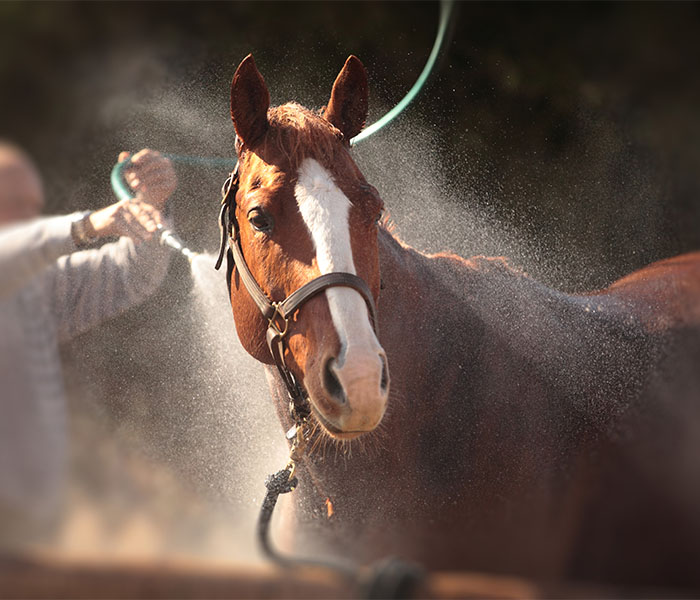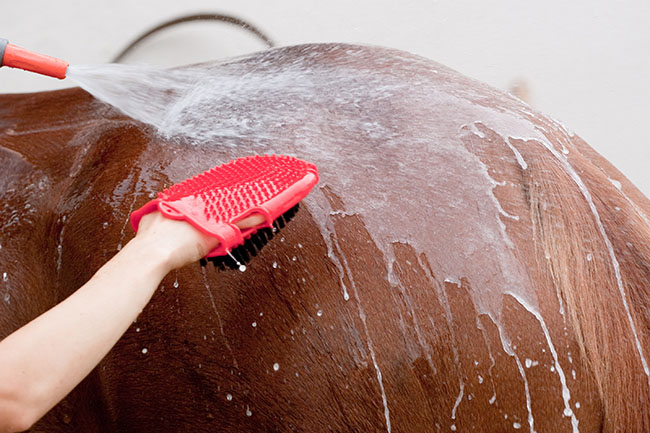
Let’s face it, horses know how to get dirty! As equestrians, we spend countless hours grooming our horses before rides, after they come in from the pasture, or just because it feels good. While daily grooming is an important part of horse husbandry, there are also a multitude of different reasons why you may want to bathe your horse.
Whether you are bathing your horse for a competition, before body clipping, after an intense workout, or just giving your horse a quality spa day, a proper bath allows you to remove dirt, sweat, dander, and excess hair from your horse’s coat without stripping the natural oils. Keep reading to learn more about how to correctly bathe your horse.
Bathing Supplies
To properly bathe your horse, you will need a handful of supplies. We recommend that you have the following on hand:
- Horse shampoo
- Horse conditioner
- Hose (or heated water supply in the winter months)
- Large body sponge
- Smaller facial sponge
- Bucket
- Rubber curry comb
- Sweat scraper
- Towels
- Cooler or anti-sweat sheet (for inclement weather)
The Bathing Process
Depending on the age, experience, and temperament of your horse, bathing your horse can be quite an adventure or a relaxing experience. We recommend that the first few times you bathe any horse that you have an experienced horse handler with you for assistance. The handler is responsible for keeping the horse safely under control while you can focus the majority of your attention on the bathing process.

- Begin by getting your horse wet. Start on one of the front legs (traditionally the left), working your way up from the ground with the hose or the sponge. This helps to acclimate your horse to the water temperature and lets them know what is about to occur. In cool weather conditions or if you have a particularly sensitive horse, consider using a system like the Schneiders Insta Hot Power Max Wash System, which provides warm water on demand and makes for a more pleasant experience for your horse.
- Once they have adjusted to the water and all of their legs are thoroughly wet, move on to the body. Start with a shoulder, then work your way to the neck, barrel, and hindquarters, with the sensitive loin area being the last part of the body that you cover with water. If you are planning to wash the mane and/or tail, spend additional time in these areas to ensure that the hair is completely soaked.
- Put a few capfuls of shampoo in your bucket and then fill with water (or follow the directions on the specific shampoo you are using). This will be what you use to initially wash your horse, just like you wash your car!
- Using your sponge, spread the soapy water all over your horse’s body, except for the head. Use caution when cleaning the genital area or underneath your horse’s tail, since horses tend to be particularly sensitive in these areas.
- Use the sponge to scrub the bony areas of your horse, like the legs. If your horse is blessed with white markings, a whitening shampoo may help you remove grass and manure stains while making them appear whiter.
- Then, use your rubber curry comb over the muscular portions of the horse’s body. Spend extra time scrubbing the dirty areas, typically the top of the horse’s hindquarters. You may need to use the sponge to spread additional lather to these areas during this step.
- Using additional soapy water, spread it on to the mane and tail (at this point you may need to refresh or refill your bucket o’ suds). Spend time scrubbing the crest of the neck and the dock of the tail because these areas tend to get extremely dirty.
- After your horse is completely lathered, it is time to begin the rinsing process. Use your sweat scraper firmly in the direction of the hair on the muscular areas of the horse’s body. This will remove a good amount of dirt and soap while allowing you to use less water for a complete rinse.
- Then use the hose (or a bucket of fresh water and a clean sponge) to rinse your horse. Begin at the neck and work your way down the body, over the mane and tail, and under the tail, rinsing until the water runs clear. This is extremely important because any soap residue left on the skin can cause irritation.
- Use your rinsed sweat scraper to remove the clean water from your horse’s coat. Pay attention to ensure that you do not see any suds during this step which would signify that you need to rinse your horse more thoroughly. To use your sweat scraper, run it firmly over your horse’s muscular areas, in the direction of the coat. Many equestrians prefer the rounded squeegee style scraper, because they conform to the shape of the horse easily; other horse owners like the traditional straight style scraper, finding them easier to grasp and maneuver. If the weather is cold or clammy, cover your horse with a cooler after this step to keep their body warm.
- To wash your horse’s head and face, use a smaller sponge and clean water. Shampoo may be irritating to your horse’s eyes and nostrils, so try to avoid it in this delicate region as much as possible. Carefully wash your horse’s face with the wet sponge, paying extra attention to the areas which accumulate sweat, such as behind the ears, and areas that collect dirt, like underneath the jowls. Work your way from the middle of the horse’s forehead to the cheeks. If your horse is accepting of this step, wipe his or her face with a clean, damp towel to complete the process.
- For a silky smooth mane and tail, we recommend that you apply conditioner (unless you are planning to braid or band, then skip this step). Use a quarter-sized amount in the mane and an additional quarter-sized amount in the tail, then comb through it with a mane and tail comb to ensure even distribution. Leave it in for up to 15 minutes for maximum moisturization before you rinse thoroughly.
- Towel dry your horse’s face and legs to discourage fungus from growing. If the weather is nice, consider hand grazing to help them dry quickly. Try to avoid putting a wet horse back into the pasture, as they will most likely roll and ruin all of your hard work! In cool weather, you may opt to towel dry the entire body to prevent your horse from catching a chill, or avoid bathing your horse entirely! To wash your horse in the winter, we recommend using waterless shampoos unless you have access to warm water and the wind-free location for bathing.
Cool Down!
In addition to cleansing your horse’s skin and coat, bathing can also help you cool down your horse’s body temperature, such as on a hot day or after a strenuous workout. Hosing or bathing horses after your ride (or on days it is too hot to ride) is one of the easiest and most effective ways to lower their body temperature.
Hosing or bathing horses is one of the easiest and most effective ways to lower their body temperature.
Using cool (but preferably not cold) water to thoroughly hose the horse and then immediately sweat scrape them. Initially, the water you scrape will be warm. Repeat this process, hosing and scraping your horse until the water that is being removed off is still cool. For additional cooling power, situate your horse underneath or in front of a heavy-duty barn fan after the bath. The moving air will facilitate evaporation and remove excess heat and moisture from your horse’s body.
From general cleanliness and show ring prep to bonding with your horse and helping them safely cool-off, there are a multitude of reasons to bathe your horse. With a bit of knowledge and the right materials, a bath can be a pleasant and enjoyable experience for everyone!
At The Cheshire Horse, we carry everything that you need to bathe your horse, no matter what the conditions may be. If you have any questions regarding the bathing process or would like personalized equine bathing product recommendations, we encourage you to speak to a member of our friendly and highly trained sales staff.
